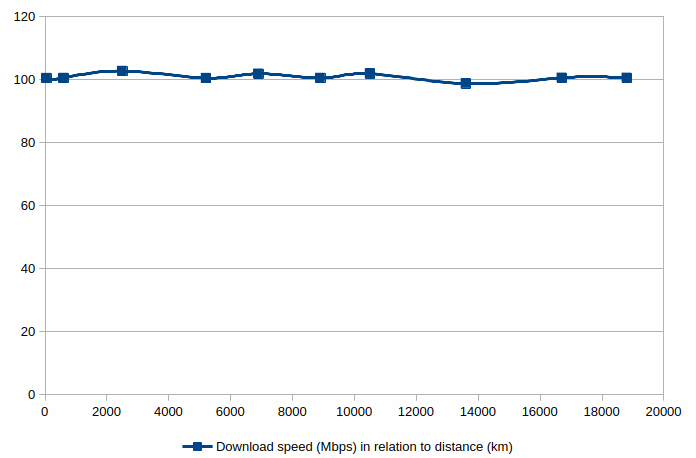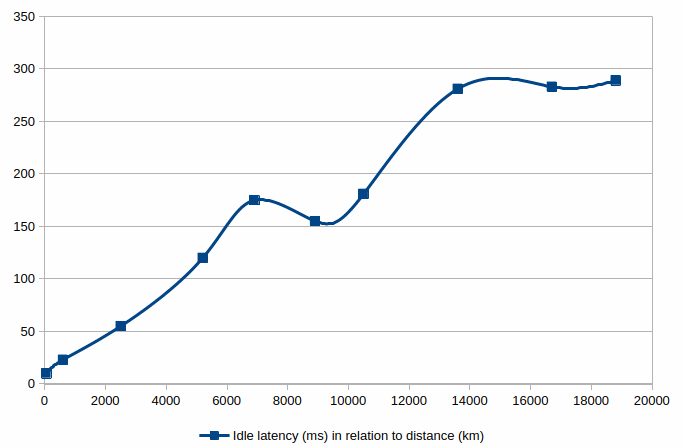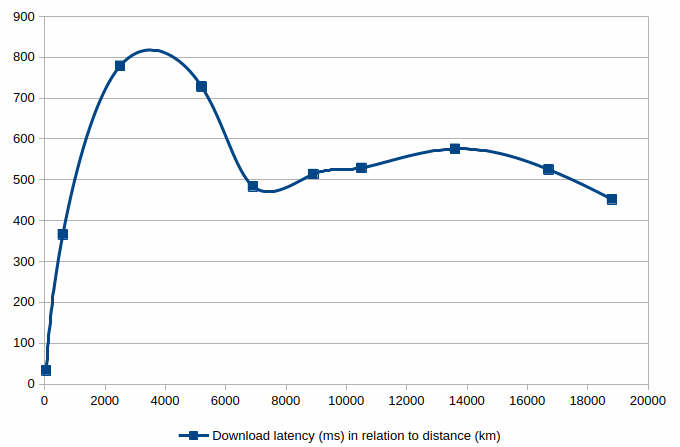TL;DR
In general, the distance to a test server has little to no effect on download speed. Latency is related to the distance to a test server.
Contents
Introduction
We know that the distance to a test server affects latency. In principle, the distance to a test server should have little to no effect on download speed. In this test, we investigate whether this is actually the case.
Method of measurement
For this test we use the original Ookla Speedtest, and we will run one speed test per test server.
One test per test server, because a previous test gives the idea that the standard deviation is so small that it is not necessary to run multiple tests per test server.
Please note that there are multiple speed tests that measure latency.
Test servers to test
We test with test servers in:
- Amsterdam (ca 50 km)
- Zurich (ca 600 km)
- Ankara (ca 2500 km)
- Quebec (ca 5200 km)
- Mumbai (ca 6900 km)
- Los Angeles (ca 8900 km)
- Singapore (ca 10500 km)
- Punta Arenas (ca 13600 km)
- Sydney (ca 16700 km)
- Dunedin (ca 18800 km)
The measurements
- Amsterdam - Odido (ca 50 km): 100.50 Mbps, idle latency: 10 ms, download latency: 33 ms, upload latency: 18 ms
- Zurich - Wingo AG (ca 600 km): 100.52 Mbps, idle latency: 23 ms, download latency: 366 ms, upload latency: 31 ms
- Ankara - Turk Telecom (ca 2500 km): 102.74 Mbps, idle latency: 55 ms, download latency: 779 ms, upload latency: 76 ms
- Quebec City, QC - Bell Canada (ca 5200 km): 100.50 Mbps, idle latency: 120 ms, download latency: 728 ms, upload latency: 126 ms
- Mumbai - Airtel Broadband (ca 6900 km): 101.88 Mbps, idle latency: 175 ms, download latency: 484 ms, upload latency: 149 ms
- Los Angeles, CA - GeoLinks (ca 8900 km): 100.53 Mbps, idle latency: 155 ms, download latency: 514 ms, upload latency: 160 ms
- Singapore - SAMBA Telecom (ca 10500 km): 101.89 Mbps, idle latency: 181 ms, download latency: 529 ms, upload latency: 220 ms
- Punta Arenas - Apoaspsis SpA (ca 13600 km): 98.75 Mbps, idle latency: 281 ms, download latency: 576 ms, upload latency: 285 ms
- Sydney - Digital Pacific (ca 16700 km): 100.58 Mbps, idle latency: 283 ms, download latency: 525 ms, upload latency: 300 ms
- Dunedin - Unifone NZ LTD (ca 18800 km): 100.57 Mbps, idle latency: 289 ms, download latency: 452 ms, upload latency: 321 ms
Conclusions
If we put these results in a graph we get the following result:
 The download speed is independent of the distance to the test server.
The download speed is independent of the distance to the test server.
 The idle latency is proportional to the distance from the Ookla test server.
The idle latency is proportional to the distance from the Ookla test server.
 The download latency is hard to relate to the distance from the Ookla test server.
The download latency is hard to relate to the distance from the Ookla test server.
 The up latency is proportional to the distance from the Ookla test server.
The up latency is proportional to the distance from the Ookla test server.
In general, the distance to a test server has little to no effect on download speed. Latency is related to the distance to a test server.